Today’s bold assertion – there never was an African vampire. Africa is hardly short of powerful and worrying myths, or tales of blood-drinking, psychic draining and the like, but… vampires? We shall argue not. And if there are such creatures there today, then they are the matter of the new urban myth, the product of colonial-era fears, or adaptations of folklore for modern fantasy and horror stories (see later below).
To put it another way, Africa never held that figure beloved of many horror readers and romanticists – the cursed or afflicted human being who dies, rises from the grave as one of the undead, and goes for the jugular, drinking blood for sustenance. No vampire in the Gothic or Stoker tradition, nor in the mould of Balkan fears; no Varney or Nosferatu or Dracula equivalent.
“(In Africa) there are any number of folkloric or legendary creatures that subsist on the blood of the living, but these are not truly the undead.”
John L. Vellutini, Editor of the Journal of Vampirology, Interview 2016
Those who like to interconnect beliefs from different cultures are often tempted to include the ‘African vampire’, as it makes a nice extra chapter – or serves as a way to tempt people into examining folklore which for once isn’t European-centred. We’re all for that last part, and for respecting African lore, but putting something under a heading doesn’t make it a vampire.
NOTE: This piece is mostly about folklore, not fiction, so we’re not covering the obvious link in Anne Rice’s novel The Queen of the Damned, where the mother of all vampires, Akasha, begins as a queen in Kemet (proto-Egypt), many thousands of years ago. According to Rice, an evil spirit captures the soul of the dying queen and pulls it back into her body, turning her into a vampire. As far as we know, there are no genuine Egyptian vampire myths.
Maybe we’ll talk about the rich and complex history of related Caribbean/Americas legends another time, but for today, let’s round up some of those African tales. These are of folk-beings which have come to be described as ‘vampire-like’ or ‘vampiric in nature’, by later, usually Western, authors already infected with the vampire concept. In addition, many accounts are second and third hand, drawn from long and varied oral traditions, and then percolated through modern sensibilities, but we’ll work with what we have…
The Asasabonsam
Almost twenty years after the publication of Stoker’s Dracula, R. Sutherland Rattray published his Ashanti Proverbs – The Primitive Ethics of a Savage People. These were apparently selected from a collection of Tshi proverbs published by the Basel Evangelical Missionary Society in 1879.
Setting aside any colonial spin and prejudice about Ashanti culture – that title gives quite a lot away (!) – Rattray describes the Asasabonsam, which belongs to the folklore of the Akan of southern Ghana, as well as Côte d’Ivoire and Togo, as:
“a monster of human shape, which living far in the depths of the forest, is only occasionally met by hunters. It sits on tree tops, and its legs dangle down to the ground and have hooks for feet which pick up any one who comes within reach. It has iron teeth. There are female, male, and little sasabonsam.”
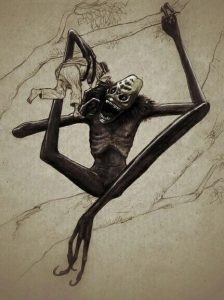
Similarly, according to A Dictionary of World Mythology, “the hairy Sasabonsam has large blood-shot eyes, long legs, and feet pointing both ways. Its favourite trick is to sit on the high branches of a tree and dangle its legs so as to entangle the unwary hunter.”
The Encyclopedia of Cryptozoology adds the following:
“During the photography of a sasabonsam sculpture in Ghana, J. B. Danquah was told by an Ashanti youth present in the crowd that a sasabonsam had once been killed by a man named Agya Wuo and brought to his town, where it had been observed by a number of people. According to the youth, Agya Wuo had come across the sasabonsam sleeping in a tree hollow in a dense forest, and fatally injured it after it “emitted a cry like that of a bat but deeper”. He took the body back to his village, where it died after making “ho, ho” noises, then on to the bungalow of District Commissioner L. W. Wood, who supposedly photographed it on 22 February 1928.
“When questioned about the incident by Danquah, Wood “seemed uncertain whether he had indeed photographed such a creature,” and cautiously said that “he may have taken the snap and the film, when developed, may have shown nothing!”. He had not been in Ashanti in February 1928, but he had been there in February 1918, making it possible that the youth had misremembered the date of the incident.”
https://cryptidarchives.fandom.com/wiki/Sasabonsam#cite_note-Danquah-4
Whatever the truth, you will note that the monster in question is neither human in origin nor undead. It is not an African vampire.
The Obayifo
The obayifo is sometimes described as a creature in its own right, and yet more properly the word refers to a broader body of beliefs and practices, often called witchcraft.
Rattray writes of the obayifo:
“(This is) a kind of human vampire whose chief delight is to suck the blood of children, whereby the latter pine and die. Men and women possessed of this power and credited with volitant powers, being able to quit their bodies and travel great distances in the night. Besides sucking the blood of their victims, they are supposed to be able to extract the sap and juices of crops. Cases of coco blight are ascribed to the work of the obayifo.
“These witches are supposed to be very common, and a man never knows but that his friend or even his wife may be one. When prowling at night they are supposed to emit a phosphorescent light. An obayifo in every day life is supposed to be known by having sharp, shifty eyes, that are never at rest, also by showing an undue interest in food, and always talking about it, especially meat, and hanging about when cooking is going on, all of which habits are therefore purposely avoided.”
Ashanti Proverbs (1916)
On the other hand, Modjaben Dowuona, a West African representative at the First International Congress of Anthropological and Ethnological Sciences in 1934 spoke more broadly on the subject of obayifo, and made it clear that obayifo represented a range of activities by certain people, not a folk monster as such:
“There are in the main two forms in which witchcraft is practised. The first takes the form of a power to do harm to other people, especially children, without any physical contact or concrete act of poisoning. Death due to poisoning is considered separate from that believed to be due to witchcraft, though in practice it is not always distinguished from it. The tendency is to ascribe to witchcraft any death which cannot be accounted for on other grounds. It seems that this non-physical way of killing was first directed against children, as is evidenced from the Twi word for witchcraft, ‘Bayi’ meaning literally ‘taking away or removing children.’ It is interesting to find that a corrupt form of the word, namely ‘obeah’ appears in the West Indies, though there it is associated with the worship of various cults.”
Quoted in Psychic Phenomena Of Jamaica by Joseph J. Williams, S.J. (1934)
So this is ‘witch lore’ – the obayifo is a willing, living human being – and not vampire lore as Europeans would know it.
The Adze
The adze is said to be a vampiric being from the folklore of the Ewe people, who are concentrated in the coastal areas of West Africa, especially Togo and Ghana.
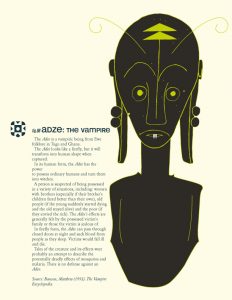
See more at https://theillustrationist.com/
Wikipedia’s entry pretty much summarises what most sources have to say about the being:
“In the wild, the adze takes the form of a firefly, though it will transform into human shape upon capture. When in human form, the adze has the power to possess humans. People, male or female, possessed by an adze are viewed as witches (“abasom” in the Ewe language). The adze’s influence would negatively affect the people who lived around their host. A person is suspected of being possessed in a variety of situations, including: women with brothers (especially if their brother’s children fared better than their own), old people (if the young suddenly started dying and the old stayed alive) and the poor (if they envied the rich). The adze’s effects are generally felt by the possessed victim’s family or those of whom the victim is jealous.
“In firefly form, the adze would pass through closed doors at night and suck blood from people as they slept. The victim would fall sick and die. Tales of the creature and its effects were probably an attempt to describe the potentially deadly effects of mosquitoes and malaria. There is no defence against an adze.”
Unfortunately for the African vampire hunter, there is no suggestion that the adze is undead or risen from the grave.
The Ramanga
The Ramanga is not that well recorded, but it is mentioned occasionally as a ‘vampire-like’ being. This belongs to the Betsileo people of Madagascar, who – whilst officially mostly Protestant or Catholic – still draw on indigenous religious beliefs, including belief in the presence of witches and diviners.
Quite what a Ramanga is remains unclear – we’ve so far found no period source material for it. Some say that it represents a person who takes on ritual roles for important tribal figures, such as drinking blood and eating nail clippings; others that it is a creature which does the same thing but for its own appetites. The jury is out, although none of the above require it to be undead – so it has no clear claim to be a African vampire, we fear.
Colonialism and Mythology
Where vampire lore in Africa does turn up again, on the other hand, is in stark reality. At the start of this post, we mentioned new urban myths and colonial-era fears. Following contemporary rumours of vampires in Malawi and nearby countries, you may come across a rather different narrative from ancient folk monsters.
“According to Tim Allen, an expert at the London School of Economics who has written on violence related to vampire stories in Uganda, large swaths of sub-Saharan Africa share broad and ancient—if shifting—beliefs in witchcraft and blood’s esoteric powers. Vampire tales proper seem to be a recent permutation on these beliefs. While Witches are traditionally described as insiders manipulating their neighbors’ lives, vampires are seen as outsiders who would steal from a community.
“Unsurprisingly, these themes gained currency in Africa about a century ago, at the height of European colonialism. Their specifics vary greatly, but such stories reflect lingering anxiety ‘about extraction and harm and uncertainty that is sometimes extremely powerful and sometimes not even mentioned,’ according to Luise White, a University of Florida historian.
“ ‘In colonial Zambia in the 1930, Africans claimed their blood was taken and their bodies left for dead to make cough drops for Europeans,’ she told me. ‘Can you think of a better description of the exploitation for luxuries for white people?’ ”
https://www.vice.com/en/article/7x4kjg/how-colonialism-fueled-deadly-anti-vampire-hysteria-in-malawi
In her own book, Speaking with Vampires – Rumor and History in Colonial Africa (2000), White says:
“I call this transnational genre of African stories vampire stories, not because I want to insert a lively African oral genre into a European one, but because I want to use a widespread term that adequately conveys the mobility, the internationalism, and the economics of these colonial bloodsuckers. No other term depicts the ease with which bloodsucking beings cross boundaries, violate space, capture vulnerable men and women, and extract a precious bodily fluid from them… Europe’s literary vampires were a separate race, which fed, slept, and reproduced differently from humans.
“Yet I worry, as historians of Africa are prone to do, that an African specificity will be lost when I invoke a dominant European term, worry that all the regional and local history in this book will be submerged into a vision of African vampires congruent with that of European lore.”
The politics of colonial and post-colonial Africa are far darker than any myth or encyclopedia of legends.
In Conclusion
So, we stick to our statement that there never was an African vampire in folklore terms (if you can prove us wrong, we’d be delighted to hear from you!). This is not in itself a problem for writers and readers – much vampire literature is fairly divorced from its Balkans folkloric origins anyway. Moldavian and Transylvanian villagers might have recognised aspects of African witch lore as related to their own striga, but would have been puzzled by dark, romantic figures flitting around siring dynasties, or conning young American women into baring those long necks…
So as far as the African vampire in contemporary fiction is concerned, anything goes. There’s even no particular reason why there can’t be a predatory upper caste Kenyan who is secretly a dracula, wears a cape, and goes out to seduce and exsanguinate the young women of Mombasa – or a Cape Town vampire queen, etc. Nomadic herders and hyenas could even do their bidding, as gypsies and wolves are in short supply down there. Quite whether or not this would read well is beyond us.
Or writers can abandon the term ‘vampire’ altogether when writing African-set stories, and focus on the nature of sickness, psychic draining and post-mortem survival in new ways – perhaps echoing aspects of obayifo and other practices. Remember that Luise White phrase: “(I) worry that all the regional and local history in this book will be submerged into a vision of African vampires congruent with that of European lore.”
Finally, note that the argument against indigenous African vampires has nothing to do with the issue of Black vampires in fiction. If vampirism is contagious, or transmissible by bite, or whatever, then vampires can be of any colour, creed or nation. Maybe science has produced them, through some insane haematological experiment; maybe Balkan legends developed from a nest of Black vampires driven across the seas.
Or maybe a century or more ago, a Black trader, scholar or seaman felt the icy breath of a dracula upon his neck…
NOTE: In that ‘vein’, we’ll be covering both Blacula and Blade the Vampire Killer later this week)
And if you want to pursue the Black vampire, 13th October 2020 sees the exciting launch of SLAY: Stories of the Vampire Noire, from Mocha Memoirs Press:
“SLAY aims to be the first anthology of its kind. Few creatures in contemporary horror are as compelling as the vampire, who manages to captivate us in a simultaneous state of fear and desire. Drawing from a variety of cultural and mythological backgrounds, SLAY dares to imagine a world of horror and wonder where Black protagonists take center stage — as vampires, as hunters, as heroes. From immortal African deities to resistance fighters; matriarchal vampire broods to monster hunting fathers; coming of age stories to end of life stories, SLAY is a groundbreaking Afrocentric vampire anthology celebrating the rich cultural heritage of the African Diaspora.”
SLAY, full of some fantastic authors, is available to pre-order now:
(The anthology even contains a brand new Mamma Lucy story, ‘Snake Hill Blues’ by the less fantastic, crumbling John Linwood Grant…)
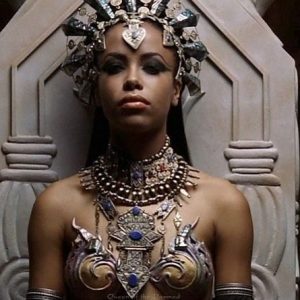
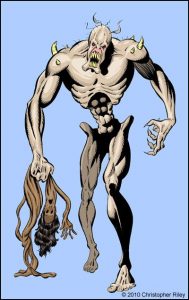
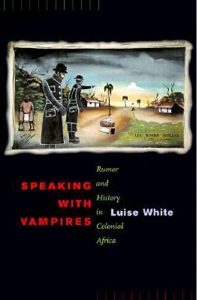

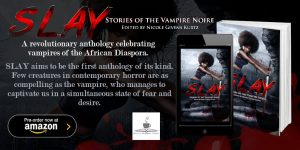
One thought on “THE AFRICAN VAMPIRE, OR WHERE NO DRACULAS ROAM”